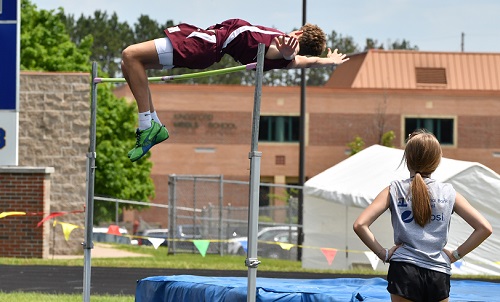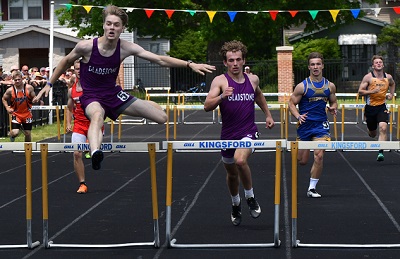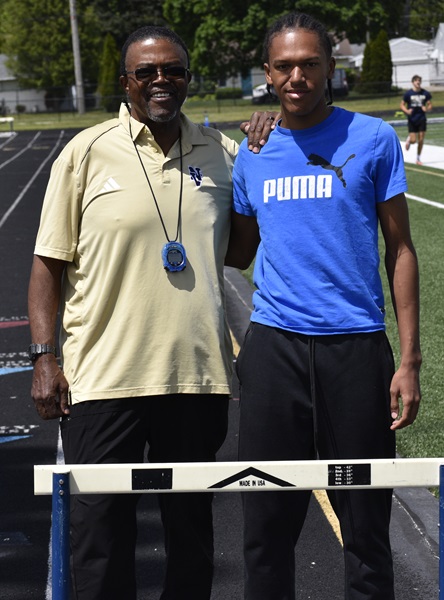
Marquette Caps Another Dominating Run as UPD1's Best
By
John Vrancic
Special for MHSAA.com
June 6, 2021
KINGSFORD — The Marquette boys have been the track & field frontrunners in the Upper Peninsula all season.
They also finished the season that way by scoring 140 points in the Upper Peninsula Division 1 Finals on Saturday at Kingsford. Gladstone – which had won the last Finals in 2019 – followed with 93 points, and third-place Kingsford had 65.
“Hats off to Kingsford for putting on such a fine meet,” said Marquette coach Kyle Detmers. “We had some good performances and our seniors were good leaders. Kam Karp had a great day, and the Vanderschaaf brothers going 1-2 in the 1,600 was huge. Cullen Papin nearly won the 800, and Owen Beauchamp, Truman Langlois and Tyranon Dahlin had nice performances.”
Temperatures hovered in the low 90s with a heat index of 99, which is believed to be the hottest U.P. Finals on record.
Sophomore Colin Vanderschaaf took the 1,600-meter run in four minutes, 31.82 seconds, edging his twin brother Carson by nine hundredths of a second.
Carson Vanderschaaf then won the 3,200 (10:24.93), and Papin was clocked at 2:01.41 in the 800, just behind Escanaba senior Derek Douglas (2:00.68).
 “It was great,” said Carson Vanderschaaf said. “I was really happy with my 1,600. I took a more conservative approach because of the heat. The breeze helped a little on the home stretch, but it was still hot.
“It was great,” said Carson Vanderschaaf said. “I was really happy with my 1,600. I took a more conservative approach because of the heat. The breeze helped a little on the home stretch, but it was still hot.
“I’m really excited for cross country this summer. With a summer full of training, I think I can improve.”
Karp won the 200 (23.24) and was runner-up to Calumet’s Dryden Nelson on a lean in the 100 (11.32) with Beauchamp third (11.44).
Nelson also took long jump at 20 feet, 6 inches with Dahlin runner-up (21-1½).
Lincoln Sager added a first for Marquette in the 400 (51.81), edging Houghton’s Donovan Dueweke by nine hundredths of a second.
Douglas’s effort on this hot and humid day was eight hundredths of a second better than his winning 800 time in Tuesday’s Northern Michigan Meet of Champions at Gaylord.
“It was a challenge trying to stay cool,” said Douglas, who will be running for St. Scholastica College in Duluth, Minn. next season. “I was sitting in front of a fan with icepacks on me, trying to stay cool.
“It feels great to get a U.P. Finals win. All the hard work I put in paid off.”
 Menominee junior Brady Schultz set the UP Division 1 Finals record and tied the school record in high jump at 6-8, edging Gladstone senior Ethan Milan who matched his own school record at 6-6. Dahlin placed third (5-10).
Menominee junior Brady Schultz set the UP Division 1 Finals record and tied the school record in high jump at 6-8, edging Gladstone senior Ethan Milan who matched his own school record at 6-6. Dahlin placed third (5-10).
“It’s good to have that competition,” said Schultz. “We really help each other out. I was happy to get the U.P. record and tie the school record. It really helps to clear 6-8. I was tired when we got to 6-9.”
The previous UPD1 record (6-5) was set by Kingsford’s Jake Richmond in 2004.
Milam previously cleared 6-6 in a triangular meet at Gladstone on May 11.
“My friend Lucas Hughes told me to keep saying to myself ‘you’re going to make it,’” said Milam. “I’m definitely pleased with my season. I set multiple records. Taking a year off (due to COVID-19) made a big difference. I had a chance to take a break. It was definitely refreshing to get track back this year.”
Gladstone senior Blake Servant was a double champion, winning the discus (151-1) and 110 hurdles (15.53), while teammate Calvin Thibault edged Servant in the 300 hurdles (40.80).
PHOTOS: (Top) Marquette's Colin Vanderschaaf (right) out-strides twin brother Carson in the 1,600 Saturday at Kingsford. (Middle) Menominee's Brady Schultz wins the high jump with a UPD1 record 6-8. (Below) Gladstone's Calvin Thibault, left, edges teammate Blake Servant in the 300 hurdles. (Photos by Cara Kamps. Click to see more at RunMichigan.com.)
McCarey Caps Niles Career Among School's All-Time Track Greats
By
Scott Hassinger
Special for MHSAA.com
June 3, 2025
NILES – For such a decorated athlete, Niles track & field star Ayden McCarey is as humble as they come.
 That one trait is what makes him such a joy to coach, says Tony Todd, the Vikings' longtime leader of the boys program.
That one trait is what makes him such a joy to coach, says Tony Todd, the Vikings' longtime leader of the boys program.
Todd, a Flint Kearsley graduate and former participant himself in the oval sport, has seen many great performers during his 27 years directing Niles' program. But he contends that McCarey is one of the best he's ever coached.
McCarey, who has signed to run track at the Division II level at Grand Valley State University, capped off a glorious high school career during Saturday's Lower Peninsula Division 2 Finals in Hamilton.
McCarey returned home with all-state honors in two events, finishing second in the 110-meter high hurdles (14.43) and third-place in the 400-meter dash (49.27). His time in the 110s broke the school record. He has the second-fastest time at the school in the 400 dash, less than a second behind 2018 Niles grad Jordan Brown, currently the Vikings' sprint coach, who owns the record at 48.50.
McCarey also qualified in the 300 intermediate hurdles and ran anchor leg for the Vikings' 1,600 relay on Saturday.
"Ayden relishes the competition. The bigger the meet, the more he seems to rise to the occasion and perform well. When someone has a faster time, he can't wait to race against them. He gets excited over the chance to compete against someone faster," Todd said.
Also a standout defender for the Niles boys soccer team, McCarey finished runners-up in both the 110 highs and 400 his junior year. As a sophomore he placed sixth in the 110 and 10th in the 300. He began competing in the 400 midway through his sophomore season.
"It's just nice to know that all your hard work you put in got you to state. There's a lot of competition there. I am just happy to represent my school for a third time," McCarey said.
He credits an increase in distance workouts and his increased focus on the 400 as big reasons for his improvement in that event this season.
 "I try and focus on all my events, but it just so happened I spent the most time focusing on the 400 this season,” McCarey said. “You need a lot of stamina to run that event, and it also helps me in the longer hurdle race as well. I've been successful in the 110 highs because I concentrate on attacking it whereas most people sometimes hop over them and that slows them down and hurts their time. I get a good start, and I'm able to maintain my speed throughout the race."
"I try and focus on all my events, but it just so happened I spent the most time focusing on the 400 this season,” McCarey said. “You need a lot of stamina to run that event, and it also helps me in the longer hurdle race as well. I've been successful in the 110 highs because I concentrate on attacking it whereas most people sometimes hop over them and that slows them down and hurts their time. I get a good start, and I'm able to maintain my speed throughout the race."
McCarey owned the fastest time in the 400 among Lower Peninsula Division 2 competitors after the Regional meet. He was ranked second in the 110 highs and fourth in the 300 entering the Finals.
"Ayden goes non-stop and never complains. He's one of those kids that will run through a wall for you,” Todd said. “Sometimes I take advantage of that to get that extra effort out of him. He is very humble, and if you try and compliment him he just smiles and puts his head down and keeps going. I worry more than he does if he doesn't get the accolades that he should. He is a quiet kid who leads by example. His form in the hurdles has improved all four years."
McCarey went through his entire high school track career without an injury.
"That's a big thing. Coaches have to learn when to pull back. He's never had a serious injury that left him having to sit out a practice. You can attribute that to his extraordinary work ethic because if you slack off, that's one of the easiest ways to get hurt,” Todd said. “He stays in shape year round with his participation in soccer and track. He is very versatile and can compete at the state level in any event from the 100 up to the 400, along with the hurdles and relays.
"His conditioning and running that he does during his soccer practice builds his endurance for track. In turn, the speed he's developed in track helps him out on the soccer field."
McCarey is looking forward to competing in college.
"I decided to go to Grand Valley because they have a solid track program, and it’s not that far from home. I liked their business program there too," McCarey said.
Todd is looking forward to seeing what McCarey can do at the next level.
"The biggest thing that will make Ayden a valuable competitor in college is that he is a natural athlete. There is only so much you can coach,” Todd said. “It takes a good coach and a good athlete to make a champion. But 90 percent of that is the athlete. If they listen and do the workouts, they will succeed.
"I couldn't be more proud of his four-year high school career. He had the most outstanding track career ever at Niles High School, and he's a great human being and student. This young man is going to do great things at Grand Valley and in life. I'm proud to have been his coach for his entire high school career."
 Scott Hassinger is a contributing sportswriter for Leader Publications and previously served as the sports editor for the Three Rivers Commercial-News from 1994-2022. He can be reached at [email protected] with story ideas for Berrien, Cass, St. Joseph and Branch counties.
Scott Hassinger is a contributing sportswriter for Leader Publications and previously served as the sports editor for the Three Rivers Commercial-News from 1994-2022. He can be reached at [email protected] with story ideas for Berrien, Cass, St. Joseph and Branch counties.
PHOTOS (Top) Niles senior Ayden McCarey leaves the starting block during the 1600-meter relay at his team’s Regional. (Middle) Niles coach Tony Todd, left, takes a photo with McCarey before the start of a practice last week. (Photos by Scott Hassinger.)

